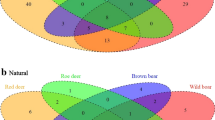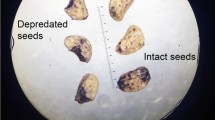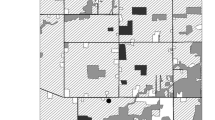Abstract
Despite of the widespread co-occurrence of multiple invaders, little is known on their combined ecological impacts and on their effects on different life stages of native species. We assessed the joint impacts of four non-native mammals (cattle, horse, European hare Lepus europaeus, and wild boar Sus scrofa) on seed surplus and seedling abundance of the Paraná pine (Araucaria angustifolia), a critically-endangered species of the Atlantic Forest. We found that its seeds constitute an autumn food resource for a native community richer than previously thought, with 70 bird and mammal species as confirmed or potential seed consumers, of which 40 were not previously recognized as such. We also recorded the number of uneaten seeds and seedlings at the middle-end of autumn under 520 female Paraná pine trees across the species’ distribution and identified signs of the species consuming seeds from each tree through direct observations combined with camera trapping. Most of the sampled trees (98%) were visited by at least one seed consumer species, and over 60% were visited by at least one non-native mammal. Seed surplus strongly declined in the presence of cattle, horses and wild boars, their impacts being additive, whereas the number of seedlings declined in the presence of European hares. Our results emphasize the importance of Paraná pine seeds for native fauna and the additive impact of invaders in a species-rich ecosystem. Seed predation by non-native species reduces the potential regeneration of Paraná pine forests, and may severely reduce food supply for its native consumers.




Similar content being viewed by others
References
Anderson DR (2008) Model based inference in the life sciences: a primer on evidence. Springer, New York
Anjos L (1991) O ciclo anual de Cyanocorax caeruleus em Floresta de Araucária (Passeriformes: Corvidae). Ararajuba 2:19–23
Arnold TW (2010) Uninformative parameters and model selection using Akaike’s information criterion. J Wildl Manag 74:1175–1178
Auguie B (2017) gridExtra: Miscellaneous functions for “grid” graphics. R package version 2.3. https://CRAN.R-project.org/package=gridExtra
Ballari SA, Kuebbing SE, Nuñez MA (2016) Potential problems of removing one invasive species at a time: a meta-analysis of the interactions between invasive vertebrates and unexpected effects of removal programs. PeerJ 4:e2029
Barretto AGOP, Berndes G, Sparovek G, Wirsenius S (2013) Agricultural intensification in Brazil and its effects on land-use patterns: an analysis of the 1975–2006 period. Glob Change Biol 19:1804–1815. https://doi.org/10.1111/gcb.12174
Bolker B, R Development Core Team (2017) bbmle: Tools for general maximum likelihood estimation. R package version 1.0.20. https://CRAN.R-project.org/package=bbmle
Brocardo CR, Pedrosa F, Galetti M (2017) Forest fragmentation and selective logging affect the seed survival and recruitment of a relictual conifer. For Ecol Manag 408:87–93. https://doi.org/10.1016/j.foreco.2017.09.046
Carr D (2018) hexbin: Hexagonal binning routines. R package version 1.27.2. https://CRAN.R-project.org/package=hexbin
de Faria GMM, Rosa CA, Castro Corrêa GL et al (2016) Geographic distribution of the European hare (Lepus europaeus) in Brazil and new records of occurrence for the Cerrado and Atlantic Forest biomes. Mammalia 80:497–505. https://doi.org/10.1515/mammalia-2015-0036
Dillenburg L, Franco AMS, Coutinho AL et al (2009) Aspectos ecofisiológicos da regeneração de Araucaria angustifolia. In: Fonseca CR, Souza AF, Leal-Zanchet AM et al (eds) Floresta com Araucária: Ecologia, Conservação e Desenvolvimento Sustentável. Holos, Ribeirão Preto, pp 57–65
Dirzo R, Young HS, Galetti M et al (2014) Defaunation in the Anthropocene. Science 345:401–406. https://doi.org/10.1126/science.1251817
Duarte LS, Dillenburg A (2000) Ecophysiological responses of Araucaria angustifolia seedlings to different irradiance levels. Aust J Bot 48:531. https://doi.org/10.1071/BT98046
Elton CS (1958) The ecology of invasions by animals and plants. Chapman and Hall, London
Galetti M, Bovendorp RS, Guevara R (2015) Defaunation of large mammals leads to an increase in seed predation in the Atlantic forests. Glob Ecol Conserv 3:824–830. https://doi.org/10.1016/j.gecco.2015.04.008
Grueber CE, Nakagawa S, Laws RJ, Jamieson IG (2011) Multimodel inference in ecology and evolution: challenges and solutions. J Evol Biol 24:699–711
Hastie TJ, Pregibon D (1992) Generalized linear models. In: Chambers JM, Hastie TJ (eds) Statistical models in S. Wadsworth & Brooks/Cole, Pacific Grove
Hegel CGZ, Marini MÂ (2013) Impact of the wild boar, Sus scrofa, on a fragment of Brazilian Atlantic Forest. Neotrop Biol Conserv 8:17–24. https://doi.org/10.4013/nbc.2013.81.03
Iob G, Vieira EM (2008) Seed predation of Araucaria angustifolia (Araucariaceae) in the Brazilian Araucaria Forest: influence of deposition site and comparative role of small and “large” mammals. Plant Ecol 198:185–196. https://doi.org/10.1007/s11258-007-9394-6
IUCN (2016) The IUCN red list of threatened species. Version 2016-2. http://www.iucnredlist.org. Accessed 7 Sep 2016
Jackson MC (2015) Interactions among multiple invasive animals. Ecology 96:2035–2041. https://doi.org/10.1890/15-0171.1
Jeschke J, Aparicio LG, Haider S, Heger T, Lortie C, Pyšek P, Strayer D (2012) Support for major hypotheses in invasion biology is uneven and declining. NeoBiota 14:1
Kleiber C, Zeileis A (2008) Applied econometrics with R. Springer, New York. https://CRAN.R-project.org/package=AER
Kuebbing SE, Nuñez MA, Simberloff D (2013) Current mismatch between research and conservation efforts: the need to study co-occurring invasive plant species. Biol Conserv 160:121–129. https://doi.org/10.1016/j.biocon.2013.01.009
Latham ADM, Warburton B, Byrom AE, Pech RP (2017) The ecology and management of mammal invasions in forests. Biol Invasions 19:3121–3139
Latorre L, Larrinaga AR, Santamaría L (2013) Combined impact of multiple exotic herbivores on different life stages of an endangered plant endemism, Medicago citrina. J Ecol 101:107–117
Levine JM, D’Antonio CM (1999) Elton revisited: a review of evidence linking diversity an dinvasibility. Oikos 87:15–26
Mantovani A, Morellato LPC, Dos Reis MS (2004) Fenologia reprodutiva e produção de sementes em Araucaria angustifolia (Bert.) O. Kuntze. Rev Bras Bot 27:787–796. https://doi.org/10.1590/S0100-84042004000400017
Martinez J, Prestes NP (2008) Tamanho populacional, tamanho médio de bando e outros aspectos demográficos do papagaio-charão (Amazona pretrei). In: J Martinez, Prestes NP (eds) Biologia da Conservação - estudo de caso com o papagaio-charão e outros papagaios brasileiros. UPF Editora, Passo Fundo, pp 178–206
Moleón M, Sánchez-Zapata JA, Selva N et al (2014) Inter-specific interactions linking predation and scavenging in terrestrial vertebrate assemblages. Biol Rev 89:1042–1054. https://doi.org/10.1111/brv.12097
Møller A, Jennions MD (2002) How much variance can be explained by ecologists and evolutionary biologists? Oecologia 132:492–500
Paise G, Vieira EM (2005) Produção de frutos e distribuição espacial de angiospermas com frutos zoocóricos em uma Floresta Ombrófila Mista no Rio Grande do Sul, Brasil. Rev Bras Bot 28:615–625. https://doi.org/10.1590/S0100-84042005000300017
Paviolo A, De Angelo CD, Di Blanco YE, Di Bitetti MS (2008) Jaguar Panthera onca population decline in the Upper Paraná Atlantic Forest of Argentina and Brazil. Oryx 42:554. https://doi.org/10.1017/S0030605308000641
Pedrosa F, Salerno R, Padilha FVB, Galetti M (2015) Current distribution of invasive feral pigs in Brazil: economic impacts and ecological uncertainty. Nat Conserv 13:84–87. https://doi.org/10.1016/j.ncon.2015.04.005
Pereira F, Ganade G (2008) Spread of a Brazilian keystone-species in a landscape mosaic. For Ecol Manag 255:1674–1683. https://doi.org/10.1016/j.foreco.2007.11.026
Prestes NP, Martinez J, Rosa AV (2008) Dieta alimentar do papagaio-charão (Amazona pretrei). In: J Martinez, Prestes NP (eds) Biologia da Conservação: um estudo de caso do papagaio-charão e de outros papagaios brasileiros. UPF Editora, Passo Fundo, pp 88–104
Prestes NP, Martinez J, Kilpp JC et al (2014) Ecologia e conservação de Amazona vinacea em áreas simpátricas com Amazona pretrei. Ornithologia 6:109–120
Prior KM, Adams DC, Klepzig KD, Hulcr J (2018) When does invasive species removal lead to ecological recovery? Implications for management success. Biol Invasions 20:267–283
R Development Core Team (2016) R: a language and environment for statistical computing. R Development Core Team, Vienna
Ragusa-Netto J (2014) Crop damage of Eriotheca gracilipes (Bombacaceae) by the blue-fronted Amazon (Amazona aestiva, Psittacidae), in the Brazilian Cerrado. Braz J Biol 74:837–843
Ribeiro JF, Vieira EM (2014) Interactions between a seed-eating neotropical rodent, the Azara’s agouti (Dasyprocta azarae), and the Brazilian pine’ Araucaria angustifolia. Austral Ecol 39:279–287. https://doi.org/10.1111/aec.12077
Sampaio AB, Schmidt IB (2014) Espécies exóticas invasoras em unidades de conservação federais do Brasil. Biodivers Bras 3:32–49
Sanguinetti J, Kitzberger T (2010) Factors controlling seed predation by rodents and non-native Sus scrofa in Araucaria araucana forests: potential effects on seedling establishment. Biol Invasions 12:689–706. https://doi.org/10.1007/s10530-009-9474-8
Selva N, Jedrzejewska B, Jedrzejewski W, Wajrak A (2003) Scavenging on European bison carcasses in Bialowieza Primeval Forest (eastern Poland). Ecoscience 10:303–311
Simberloff D, Martin JL, Genovesi P et al (2013) Impacts of biological invasions: what’s what and the way forward. Trends Ecol Evol 28:58–66. https://doi.org/10.1016/j.tree.2012.07.013
Solórzano-Filho JA (2001) Demografia, fenologia e ecologia da dispersão de sementes de Araucaria angustifolia em uma população relictural em Campos do Jordão. University of São Paulo, São Paulo
Souza AF, Forgiarini C, Longhi SJ, Brena DA (2008) Regeneration patterns of a long-lived dominant conifer and the effects of logging in southern South America. Acta Oecol 34:221–232. https://doi.org/10.1016/j.actao.2008.05.013
Tella JL, Lambertucci SA, Speziale KL, Hiraldo F (2016a) Large-scale impacts of multiple co-occurring invaders on monkey puzzle forest regeneration, native seed predators and their ecological interactions. Glob Ecol Conserv 6:1–15. https://doi.org/10.1016/j.gecco.2016.01.001
Tella JL, Dénes FV, Zulian V et al (2016b) Endangered plant-parrot mutualisms: seed tolerance to predation makes parrots pervasive dispersers of the Parana pine. Sci Rep 6:31709. https://doi.org/10.1038/srep31709
Thomas P (2013) Araucaria angustifolia. IUCN red list threat species 2013 e.T32975A2829141
Venables WN, Ripley BD (2002) Modern applied statistics with S, 4th edn. Springer, New York
Vieira EM, Iob G (2009) Dispersão e predação de sementes de Araucaria angustifolia. In: Fonseca CR, Souza AF, Leal-Zanchet AM et al (eds) Floresta com Araucária: Ecologia, Conservação e Desenvolvimento Sustentável. Holos, Ribeirão Preto, pp 85–95
Vieira EM, Ribeiro JF, Iob G (2011) Seed predation of Araucaria angustifolia (Araucariaceae) by small rodents in two areas with contrasting seed densities in the Brazilian Araucaria forest. J Nat Hist 45:843–854. https://doi.org/10.1080/00222933.2010.536265
Wickham H (2009) ggplot2: Elegant graphics for data analysis. Springer, New York
Zamorano-Elgueta C, Cayuela L, González-Espinosa M et al (2012) Impacts of cattle on the South American temperate forests: challenges for the conservation of the endangered monkey puzzle tree (Araucaria araucana) in Chile. Biol Conserv 152:110–118. https://doi.org/10.1016/j.biocon.2012.03.037
Acknowledgements
We thank G. Ferraz and managers and staff of Estação Ecológica de Aracuri-Esmeralda, Floresta Nacional de São Francisco de Paula and Centro de Pesquisas e Conservação da Natureza Pró-Mata (PUC-RS). We are grateful to James Russell, and an anonymous reviewer for their helpful comments and suggestions. We also thank Andrew Crosby for the English review. Funds were provided by Fundación Repsol. F.V.D. was funded by Conselho Nacional de Desenvolvimento Científico e Tecnológico (206107/2014-5). N.P. and J.M. thank the Fundação Grupo Boticário de Proteção à Natureza for financial support of long-term work on parrots in southern Brazil.
Data accessibility
The dataset with seed and seedling counts and covariates for all observations, and the analysis R code file are uploaded as online supporting information.
Author information
Authors and Affiliations
Contributions
FH, FVD and JLT designed the work; FH, FVD, JLT, VZ, NM and JM conducted field work; FVD and JLT analysed the data; FVD led the writing of the manuscript. All authors contributed critically to the drafts and gave final approval for publication.
Corresponding author
Electronic supplementary material
Below is the link to the electronic supplementary material.
Appendix S2
CSV dataset with seed and seedling counts and covariates used in modeling analysis (CSV 23 kb)
Rights and permissions
About this article
Cite this article
Dénes, F.V., Tella, J.L., Zulian, V. et al. Combined impacts of multiple non-native mammals on two life stages of a critically endangered Neotropical tree. Biol Invasions 20, 3055–3068 (2018). https://doi.org/10.1007/s10530-018-1758-4
Received:
Accepted:
Published:
Issue Date:
DOI: https://doi.org/10.1007/s10530-018-1758-4




